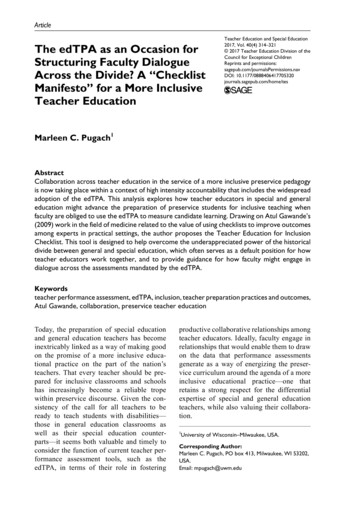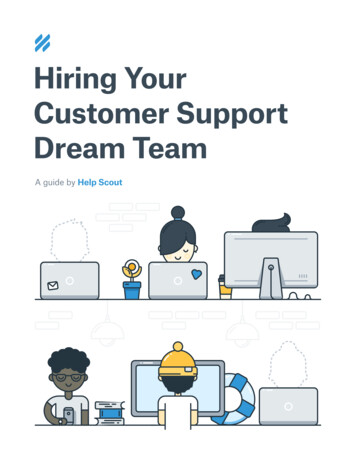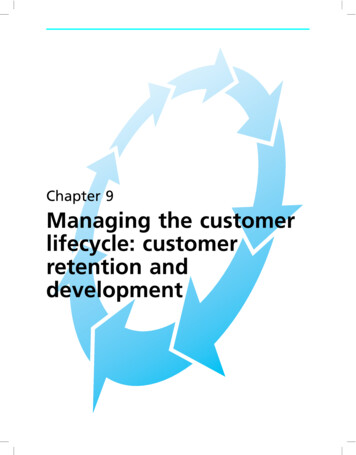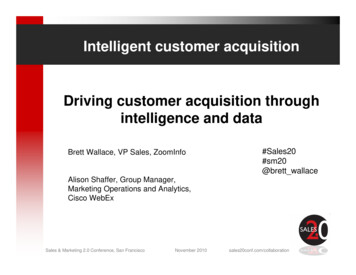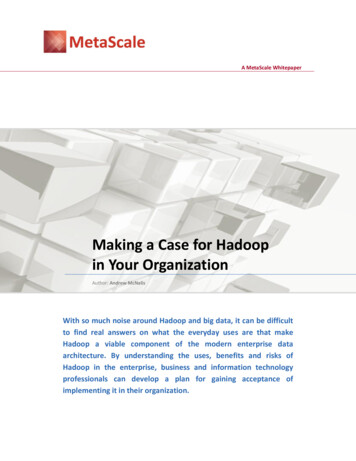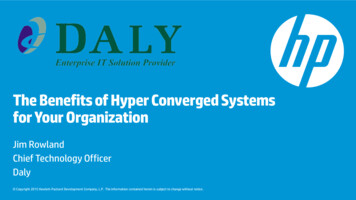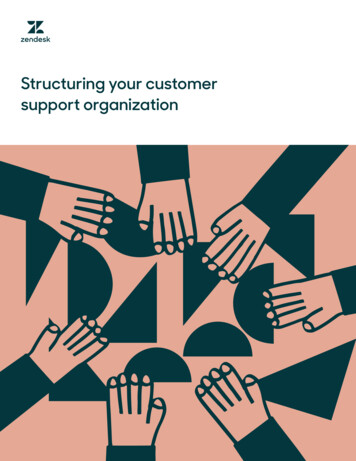
Transcription
Structuring your customersupport organization
Structuring your customer support organization2To quickly scale your customer serviceorganization, you need to continuouslyrethink how to best provide support, whatkind of people and skills you need, andhow you’re going to organize it all.That’s what this guide is all about. It’s the lessons we’ve learned at Zendeskover many years of rapid growth and—as a result—how we structure ourcustomer service organization around specific teams, tiers, and roles.We define success as a combination of people, process, and technology—where the people part always comes first. One of our most importantinitiatives over the last several years has been our focus on building thatpeople-first approach to customer service.Key to that is providing well-defined roles and performance expectations,which gives everyone on the team an understanding of what they should beachieving and their career path options and goals to work toward.This guide represents the work of many present and former Zendesksupport team leaders who managed the support organization to keep pacewith the company’s growth and to continuously provide a great customersupport experience.What you’ll find here is a framework of the core elements of a customerservice organization that you can use to build out your own organization.
The roles, teams, and tiers301The roles, teams,and tiersThe Zendesk Global Customer AdvocacyThe Global Custom Advocacy team includesteam includes more than 250 people and isthe people who interact directly with customersspread out across eight locations around theand solve tickets, a team devoted to supportingworld. The organization has been structuredthose customer-facing teams by buildingaround functional teams and tier levels ofworkflows and tools to make their jobs easier,customer support to reflect increasing levelscustomer service data analysts, trainers, theof complexity and the skills and experiencemanagement staff, and people who manageneeded to handle that complexity.projects and programs across the organization.
The roles, teams, and tiers4How the organizationis structuredThe Global Customer Advocacy teamsare currently organized into these threemain functions: Tier 1 Customer Advocacy(Product Support) Tier 2 & 3 Customer Advocacy(Technical Support) Support Operations(Advocacy Operations)The advocacy teams are organized into tiersto manage complexity. Tier 1 handles theeasiest support issues, and Tier 3 takes themost difficult. We’ll talk much more abouteach of these tiers in the following sections.Directors lead each of these functions, withmanagers reporting to them in office locationsacross the globe. In other words, Directorlevel leadership is global, not regional. Allthree of these functions are global andco-located with each other. This makes sensefor Zendesk because of how closelyintegrated these teams are.There are some inevitable regional andproduct-specific differences in how teams aremanaged and how processes are developedand followed, but the Directors align thesewith the organization’s overall goals andperformance expectations.All of the teams in the Zendesk GlobalCustomer Advocacy organization report to theVice President of Global Customer Advocacy.Organization and management structures arealways changing to adapt to the growth andchanges in the business. Therefore, how youorganize your customer service team at thislevel will reflect your own company’s needsand circumstances.Tiers and retentionThe needs to scale our organization to keepup with our rapid growth, increasingcomplexity, and ticket queue volume weren’tthe only drivers for implementing a tierstructure. Employee retention was justas important.Before we had tiers, Advocates’ only optionto advance their careers was a move intomanagement, support operations, or anotherrole in the company.Providing levels of seniority within theAdvocacy team gives people who are happyin a customer-facing support role theopportunity to demonstrate peer leadershipand gain status, while staying in a job thatthey love. What better way to retain thosegreat employees?
The roles, teams, and tiers5Growth tipping pointsThere’s no single perfect formula for growinga customer service organization, but there aresome key milestones that you can considerimportant growth tipping points.When is it time to add aSupport Operations team?When you need someone working full-timeon your support process and workflow tasks,which means that they’re too busy to helpcustomers. We discuss this in more detail inSupport Operations.When it is time to add a tier?When your support team is splitting their timebetween the easy half of their queue (ticketsthat can be solved quickly) and the difficult halfof their queue (tickets that require much moretime and effort or specialized tools or skills).When is it time to specialize?When it is time to triage tickets?As complexity increases, it’s impossible foreveryone on the team to have in-depthknowledge about all the parts. Some peoplebecome experts in some areas, but you can’tscale effectively with only one go-to person inthose areas. We discuss how you can handlethis in Managing complexity with Tier 2squads.Increased complexity also means that youneed to be smarter about assigning incomingtickets. To do this, you need to add a triagestep so that you can more thoughtfully directsupport issues to the people who have theknowledge required to resolve them. Readmore about how we handle this in Zendesk onZendesk: How we triage.Tier 0, making the most of self-serviceever-increasing amount of incoming supportrequests that can be easily answered withthese self-help resources.Reflecting the importance of providingexcellent self-service to manage rapid growthand satisfy customers, the CustomerAdvocacy team recently launched Tier 0.This is the self-service tier: the supportavailable to customers that does not requiredirectly interacting with a customer advocate.This includes the knowledge base availablein an online Help Center: the product trainingthat is available to customers, as well asassistance that is available in the product’suser interface.Tier 0 isn’t a staffed team, it’s an initiative tobetter contribute to and manage self-serviceas a support channel; to better handle anThere are two goals for Tier 0. The first is topractice knowledge-centered support(KCS), which means that reps are bothgenerating and sharing knowledge-basecontent (internally and with customers).The second goal is to devise ways to helpcustomers discover and use that self-helpcontent. An example of this is to useproactive support to spot an issue that acustomer is having or is about to have, thenproactively create a ticket that contains alink to the knowledge-base article that willhelp them resolve it themselves.
The roles, teams, and tiers6Key Takeaways01Although your Support team may be small today, it’s agood idea to think about where it will be several yearsdown the road and define roles and an organizationalstructure that will help you scale.02Create an organizational and management structurethat makes sense for your own company. Getting thefunctional teams in place is key; determining who theyreport to is part of the ongoing management of thegrowth of your organization.03Consider the complexity involved in the support youprovide, the skills required to manage that complexity,and how you can organize to handle it effectively.
Customer Advocates702CustomerAdvocatesThe Customer Advocate teams directly interactIn general, support issues assigned to Tier 1 arewith customers to help them quickly solve theireasier and take less time to solve than thoseproblems and ensure customer satisfactionassigned to Tiers 2 and 3.remains high.Zendesk uses the “advocates” job title becauseThe Customer Advocates are organized intothat reflects our customer-first approach to3 team tiers that reflect levels of complexity.customer service. You’ll also see “agent,” “rep,”Tier 1 is for general product support, Tier 2 isand many other titles used across differentfor technical support, and Tier 3 is for advancedcustomer service organizations.technical support and engineering escalations.
Customer Advocates8TIER 1Providing generalproduct supportThe Customer Advocates in Tier 1provide general product supportacross one or more products.This includes things like helping customersset up their accounts, resolving billing issues,helping them understand how the productworks, and any other help customers need touse the product.Tier 1 is also the first point of contact forincoming support issues. This is where allincoming tickets are triaged and then routedto the appropriate team or tier. The Tier 1team also handles all incoming phone callsand chats.Experienced Tier 1 Advocates take turnstriaging tickets and determining how theyshould be assigned based on complexity,which is defined by the time needed toresolve the issue. Support issues that areassigned to Tier 1 are expected to take 15minutes or less to resolve. If a support issueis more complex and requires more time toresolve, it’s assigned to Tier 2.Tier 1 includes these Customer Advocate roles: Associate Customer Advocate Customer Advocate Sr. Customer AdvocateWe also talk about a Team Lead individualcontributor role in Customer AdvocateManagement.Associate Customer AdvocateSr. Customer AdvocateThis is the team’s entry-level role. We look forpeople with potential, who have a year or twoof experience helping customers in somecapacity, and who possess essential customerservice skills.A promotion to Senior is possible afterabout 9 months of successfully working asan Advocate. Advocates must demonstratethat they can proactively identify problemareas and mentor and train other customeradvocates on how to solve more difficulttickets.Associates are in training and need guidanceto perform at the standard level set forcustomer advocates. We set a target fortickets solved per day and expect an overallcustomer satisfaction (CSAT) rating of 90%.Associates are usually in this role for at least 3months before becoming full-fledgedAdvocates.Customer AdvocateAdvocates are well-trained and can handlemost types of general support issues;therefore, they don’t “cherry pick” tickets.Their performance is measured by the numberof tickets they solve per day and by theirCSAT rating, which should be at least 95%.A Senior’s performance should be abovethe standard, and they should also have anaverage CSAT rating of 96%. They oftenspecialize in one or more product areasand are considered experts in those areas.
Customer Advocates9The Importance of MentoringBenjamin Towne, a Tier 1 Customer Advocate,was one the earliest employees in theMadison, Wisc., office and helped grow theadvocate team by rolling out the advocatementor program. One of the first of twomentors in the program, he’s mentored manyteam members and has some good adviceabout how to do it the right way.You can read more about Benjamin and thementor program he helped develop in How toprovide feedback to mentees that doesn’tsound like criticism.It’s really good to make a mentee feel like they aren’tjust another employee. They’ve been brought into afamily or a team, and they have someone they can goto. A manager might ask an advocate to get somethingdone, but a mentor is there to help them do it. Your oldmentees should always be able to come up and still askquestions. It’s also a great way to form relationshipswith new coworkers.I think sometimes Tier 1 support is overlooked. Havinga Tier 1 title doesn’t mean that you’re the lower endof support. For me, it’s one of the most difficult groupsin support. You need to learn the entire product as awhole because you get all sorts of different tickets inthe queue. I’ve worked on other tiers, and the ticketsare increasingly difficult. But the way you interact withcustomers tends to be more personal at Tier 1.The Tier 1 ChallengeArthur Mori, a Team Lead for Tier 1 Manila,has worked in all three support tiers, but heprefers Tier 1 because he likes interactingwith customers.You can read more about Arthur and hisrole as a Team Lead in “Tier 1: The mostdifficult level of support?”
Customer Advocates10Essential Skills forCustomer AdvocatesLearn more about essential customer serviceskills to recruit, hire, and onboard customerservice representatives.EmpatheticMaster of simplicityPeople in customer service roles shouldgenuinely want to help other people. Thatdesire begins with empathy: willingness tounderstand another person’s experience andsee it through their eyes.When a customer makes the effort to reachout and ask for help, it’s the Advocate’s job toquickly assess the problem, sort it all out, andthen present the customer with the simplestanswer possible.Internet savvyGrowth mindsetThe internet and mobile computing provide uswith more ways than ever to communicatewith each other. We refer to these as channels, and we often provide customer servicesimultaneously on many different channels.Products, technology, and policies willchange over time, and your Advocates willneed to change with them. Look for peoplewho have demonstrated a drive for learningand growing.Strong communicatorThis job is about communicating with otherpeople. Advocates need to communicate wellboth verbally and in writing. Communicationis about listening, then clearly articulatingideas and information in an authentic way.
Customer Advocates11TIER 2Where specializationconquers complexityTier 2, referred to as Technical Support, handlesmore complex support issues that require morein-depth knowledge of the product or a deepertechnical understanding of it.This team often helps customers with issuesthat involve aspects of the product that are nothandled by the user interface—for example,resolving issues related to uploading data,making add-ons or companion products interactproperly, and anything else that requires adeeper dive into the underlying technology.The tickets that are assigned to this team areexpected to take 30 minutes or less to resolve.If a support issue can’t be handled in thatamount of time, it’s escalated to the Tier 3 team.Tier 2 includes these roles: Technical Support Engineer Sr. Technical Support EngineerTechnical Support Engineers typically join thisteam after having been a Customer Advocateand developing expertise in one or more areasof the product. We hire people for this positionfrom outside the company, as well.Technical Support EngineerSr. Technical Support EngineerTypically, Advocates move into the SupportEngineer role after having been an Advocatefor at least one year. Of course, they alsoneed to have developed in-depth technicalknowledge about one or more product areas.For people with technical ability, this is thenext step in their technical career track.A Senior has usually mastered multipleproduct areas, leads productivityimprovements, and defines best practiceswithin those product areas.Like Advocates, Support Engineers have atarget for tickets solved per day (a lowernumber than for Advocates because theissues they work on are more complex) andan average CSAT rating goal of 94%.They’re recognized as a point of contact fortheir product areas across the entire customerservice organization, and they collaborateclosely with the Product and Developmentteams to represent the needs of customers.They have a target for tickets solved per dayand need to achieve an average CSAT rating of95%.
Customer Advocates12Managing complexitywith Tier 2 squadsBecause Zendesk has a large and quicklygrowing suite of products, the SupportEngineers in Tier 2 are organized into“squads.” There are currently four squads.The first squad is for general Tier 2 supportissues (in other words, the more complexissues that Tier 1 can’t handle, which also arenot specific areas of the product that arehandled by the other three squads). All newTier 2 team members are assigned to thissquad. This gives them a chance to masterthe easiest part of the Tier 2 job before divinginto the more complex areas.The other three “specialist” squads haveresponsibility for a portfolio of different aspectsof the products (for example, one squadhandles all the escalated tickets for a productlike Zendesk Talk or the reporting tools).Tier 2 Support Engineers are expected to(and want to) cycle through the threespecialist squads. This gives them theopportunity to master all the areas of ourproducts. Doing so also helps prepare themfor a move into Tier 3.As members of specialized squads, Advocatesdevelop product expertise in those areasbecause they’re focused on them and aren’tpulled in too many other directions. Theexpertise that they develop helps theorganization handle complexity and resolveissues more quickly.Teamwork and creativityGuillaume Deleeuw, Team Lead for Tier 2Technical Support in London, believes thatworking together is the best way to approachproblems and come up with creative solutions.You can read more about Guillaume and hisrole as a Tier 2 Team Lead in “An unlikelyadvocate for Advocacy.”Tier 2 often works with the development team, theproduct team, the operations team, and others,depending on whether we’re troubleshooting issueswith the product, network, or the infrastructure. Forany issue, we might work with multiple teams at thesame time, or one team at a time. Even when issuesare super technical, there are usually many ways toapproach the problem and to work together towarda positive end result.
Customer Advocates13TIER 3Tackling thetoughest issuesTier 3 is the highest level of technical support.This team handles the toughest issues, thetickets that have been escalated from Tier 2(usually 5–10% of the total ticket volume).These tickets have no time limit for resolution;they take as long as they as take to resolve.They’re often issues that are hard to replicateand may be dependent on products orinfrastructure beyond our own products.This team also vets all issues that needescalation to the software development team,tests the fixes put in place by the developmentteam, and then resolves the issue forthe customer.Tier 3 includes these roles: Technical Support Architect Sr. Technical Support ArchitectTechnical Support Architects have masteredmultiple parts of the product (becausethey’ve participated in Tier 2 squads) and, asliaisons to the Product and Developmentteams, help each of those teams understandwhere the product can be improved and how.Technical Support EngineerSr. Technical ArchitectWithin the Advocacy organization, theArchitect (and Sr. Architect) role is the finalstop in direct technical support of customers.Continuing to pursue the technical careertrack beyond the Architect role means movinginto a role in the non-customer–facing SupportOperations Engineering team or in theSoftware Development team.A promotion to Senior requires a minimum 2years of experience as a Technical Architect.A Sr. Technical Support Engineer with at least1.5 years in that role usually has the requiredexperience to move into the Architect role.They also interact directly with VIPcustomers to provide a high-touch technicalsupport experience when needed.The difference between a Support Engineerand an Architect is experience, subject matterexpertise and technical mastery, and theirinfluence in the organization. They’re expectedto provide guidance and best practices forproviding support for their areas of productexpertise. They are trainers and mentors.Sr. Technical Architects have a daily ticketsolve target and an average CSAT ratinggoal of 92%.Technical Architects have a daily ticket solvetarget and an average CSAT rating goal of 90%.At this level, Seniors are excellent atcommunicating complex customer issues tosoftware development teams and can makesuggestions for improving the product andinfluencing the product roadmap.
Customer AdvocatesThe team has to have persistence and patience; a lotof the issues take a long time. We have to have a broadscope—to have wide knowledge
Although your Support team may be small today, it’s a good idea to think about where it will be several years down the road and define roles and an organizational structure that will help you scale. Create an organizational and management structure that makes sense for your own company. Getting the


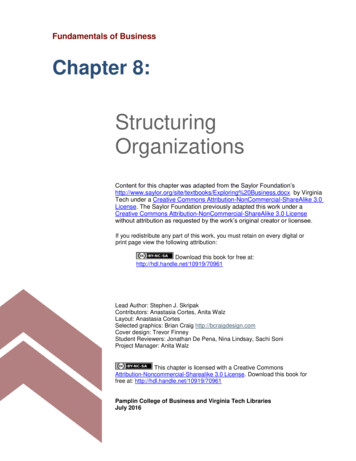
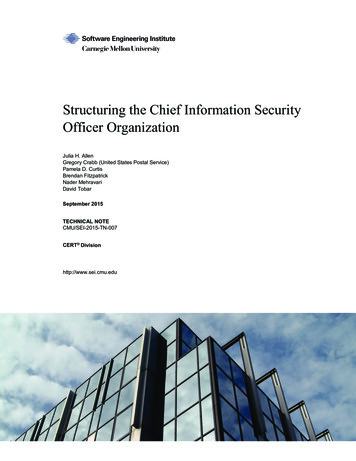
![Upskilling and Structuring [Teams] for Predictive Analytics](/img/11/pd-2018-insurtech-session-6.jpg)
